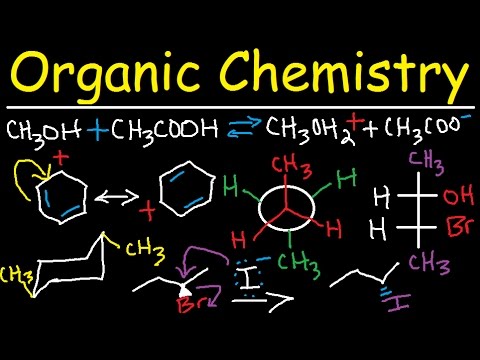This video tutorial provides an introduction or basic overview on what you will learn in your first college semester of organic chemistry.
Subscribe:
Organic Chemistry Playlist:
.:
Organic Chemistry Textbooks:
Here is a list of topics covered in this video:
1. How To Draw Lewis Structures of Organic Compounds
-Butane, Hexane, 2-methylpentane, 2-chloro-3-bromoheptane, 2,2,3,3-tetramethylbutane, 2-butene, and 3-hexyne
2. How To Draw a Line Structure From a Condensed Structure:
CH3CHCH2, (CH3)3CCH2CCH, (CH3)2CHCH2CH2
3. How to Draw The Lewis Structure of Functional Groups
Alcohols, Carboxylic Acids, Esters, Aldehydes, Ketones, Alkyl Halides, Ethers, Amines, Amides, & Ionic Structures
4. Octet Rule, Multiple Bonding, Nonbonding Electrons, & Valency of Elements Such as Carbon, Nitrogen, Oxygen, & Halogens like Fluorine, Bromine, and Chlorine
5. How To Calculate The Formal Charge of an Element
6. How To Draw Resonance Structures and How To Identify The Major Resonance Contributor
7. Acids and Basic Periodic Trend – Pka & Resonance Stabilization of the Conjugate Base
8. How To Predict The Products of an Acid Base Reaction In Organic Chemistry
HBr + H2O
CH3COOH + CH3OH
CH3SH + CH3OH
9. How To Use Pka To Determine Where Equlibrium Will Shift Either To The Left or To The Right For Acid Base Reactions
CH3COO- + CH3OH — CH3COOH + CH3O-
HO- + NH3 — NH2- + H2O
CH3O- + CH3SH — CH3OH + CH3S-
10. How To Find The Hybridization, Bond Angle, and Molecular Geometry of every carbon atom or nonhydrogen atom in a compound.
11. How To Draw Sigma and Pi bonds For Ethene
12. How To Determine How Many Sigma and Pi Bonds Are In a Compound or Molecule.
13. Electronegativity and Bond Polarity
14. How To Draw Hydrogen Bonds In Water
15. The Difference Between Hydrogen Bonds and Covalent Bonds – 16. Intermolecular Bonds vs Intramolecular Bonds
17. How To Determine Which Compounds Are Polar vs Nonpolar
18. How To Know Which Compounds Are Soluble in Water – Miscible or Immiscible
19. Cis and Trans Geometric Isomers of 2-butene – No Rotation around Double Bonds
20. Conformations of Butane – Anti, Gauche, Eclipsed, Staggered, and Totally Eclipse
21. How To Draw The Newman Projection of 2-methylbutane along the C2-C3 bond
22. Angle & Ring Strain of Cycloalkanes – Cyclopropane, Cyclobutane, Cyclopentane, and Cyclohexane
23. Chair Conformations of Cyclohexane – Axial vs Equatorial Bonds
24. 1,3-diaxial Strain
25. How To Draw The Most Stable Chair Conformation of 1-tert-butyl-4-methylcyclohexane
26. Cis and Trans Chair Conformation For Cyclohexane
27. How To Determine if a Carbon Atom Is Chiral or Not
28. Enantiomers – Mirror Images – Physical Properties vs Optical Properties
29. How To Determine How Many Chiral Centers or Stereocenters Are in a Compound
30. How To Determine How Many Stereoisomers Are In a Compound
31. How To Determine R/S Configuration For a Chiral Center
32. How To Draw Fischer Projections
33. How To Assign R/S Absolute Configuration For Fischer Projections
34. Enantiomers, Diastereomers, Constitutional Isomers, & Meso Compounds
35. Addition, Substitution, Elimination & Rearrangement Reactions
36. SN2 Reactions – Nucleophile vs Substrate, 2nd Order Nucleophilic Substitution, Rate Law, Inversion of Stereochemistry, & Energy Diagram, Polar Aprotic Solvents
37. SN1 Reactions – Protic Solvents, Unequal Racemic Mixture – Retention & Inversion, First Order Nucleophilic Substitution
38. E1 Reactions – Carbocation Intermediate & First Elimination Process
39. E2 Reactions – Concerted Reaction Mechanism, Strong Unhindered vs Bulky Base – Hoffman vs Zaitsev – Major vs Minor Product
40. Electrophilic Addition Reactions of Alkenes
41. Hydrohalogenation Reactions of Alkenes – 1-butene + HBr and Peroxides
42. Regiochemistry – Markovnikov vs Anti-Markovnikov Addition
43. Stereochemistry – Anti vs Syn Addition
44. Steoreoselectivity vs Regioselectivity
45. Hydroboration Oxidation, Oxymercuration Demercuration, and Hydration
46. Hydrogenation, Bromination, and Syn Hydroxylation of Alkenes
47. Enantiomers & Meso Compounds – Alkene + Br2 – 1 vs 2 Products
48. Electrophilic Addition Reactions of Alkynes
49. Hydrogenation of Alkynes into Cis & Trans Alkenes Using H2/Lindlar’s Catalyst and Na with NH3
50. Alkynes into Aldehydes & Ketones Using (Sia)2BH, THF and HgSO4, H2SO4, and H2O
51. Synthesis Reactions With Acetylene – C2H2 & NaNH2 With an Alkyl Halide like CH3Br and CH3CH2Br
52. Oxidation and Reduction Reactions of Alcohols
53. Oxidizing Agents of Alcohols – PCC, Na2Cr2O7 + H2SO4, H2CrO4 & KMnO4 – H3O+

